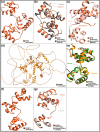Functional and structural analysis of non-synonymous single nucleotide polymorphisms (nsSNPs) in the MYB oncoproteins associated with human cancer
- PMID: 34921182
- PMCID: PMC8683427
- DOI: 10.1038/s41598-021-03624-x
Functional and structural analysis of non-synonymous single nucleotide polymorphisms (nsSNPs) in the MYB oncoproteins associated with human cancer
Abstract
MYB proteins are highly conserved DNA-binding domains (DBD) and mutations in MYB oncoproteins have been reported to cause aberrant and augmented cancer progression. Identification of MYB molecular biomarkers predictive of cancer progression can be used for improving cancer management. To address this, a biomarker discovery pipeline was employed in investigating deleterious non-synonymous single nucleotide polymorphisms (nsSNPs) in predicting damaging and potential alterations on the properties of proteins. The nsSNP of the MYB family; MYB, MYBL1, and MYBL2 was extracted from the NCBI database. Five in silico tools (PROVEAN, SIFT, PolyPhen-2, SNPs&GO and PhD-SNP) were utilized to investigate the outcomes of nsSNPs. A total of 45 nsSNPs were predicted as high-risk and damaging, and were subjected to PMut and I-Mutant 2.0 for protein stability analysis. This resulted in 32 nsSNPs with decreased stability with a DDG score lower than - 0.5, indicating damaging effect. G111S, N183S, G122S, and S178C located within the helix-turn-helix (HTH) domain were predicted to be conserved, further posttranslational modifications and 3-D protein analysis indicated these nsSNPs to shift DNA-binding specificity of the protein thus altering the protein function. Findings from this study would help in the field of pharmacogenomic and cancer therapy towards better intervention and management of cancer.
© 2021. The Author(s).
Conflict of interest statement
The authors declare no competing interests.
Figures



Similar articles
-
Predicting the functional and structural consequences of nsSNPs in human methionine synthase gene using computational tools.Syst Biol Reprod Med. 2019 Aug;65(4):288-300. doi: 10.1080/19396368.2019.1568611. Epub 2019 Jan 24. Syst Biol Reprod Med. 2019. PMID: 30676783
-
Investigating the functional and structural effect of non-synonymous single nucleotide polymorphisms in the cytotoxic T-lymphocyte antigen-4 gene: An in-silico study.PLoS One. 2025 Jan 24;20(1):e0316465. doi: 10.1371/journal.pone.0316465. eCollection 2025. PLoS One. 2025. PMID: 39854591 Free PMC article.
-
Investigating the structural and functional consequences of germline single nucleotide polymorphisms located in the genes of the alternative lengthening of telomere (ALT) pathway.Heliyon. 2024 Jun 18;10(12):e33110. doi: 10.1016/j.heliyon.2024.e33110. eCollection 2024 Jun 30. Heliyon. 2024. PMID: 39021990 Free PMC article.
-
Computational prediction of the effects of non-synonymous single nucleotide polymorphisms in human DNA repair genes.Neuroscience. 2007 Apr 14;145(4):1273-9. doi: 10.1016/j.neuroscience.2006.09.004. Epub 2006 Oct 19. Neuroscience. 2007. PMID: 17055652 Review.
-
Approaches and resources for prediction of the effects of non-synonymous single nucleotide polymorphism on protein function and interactions.Curr Pharm Biotechnol. 2008 Apr;9(2):123-33. doi: 10.2174/138920108783955164. Curr Pharm Biotechnol. 2008. PMID: 18393868 Review.
Cited by
-
Expression pattern and clinical value of Key RNA methylation modification regulators in ischemic stroke.Front Genet. 2022 Oct 3;13:1009145. doi: 10.3389/fgene.2022.1009145. eCollection 2022. Front Genet. 2022. PMID: 36263422 Free PMC article.
-
From modulation of cellular plasticity to potentiation of therapeutic resistance: new and emerging roles of MYB transcription factors in human malignancies.Cancer Metastasis Rev. 2024 Mar;43(1):409-421. doi: 10.1007/s10555-023-10153-8. Epub 2023 Nov 10. Cancer Metastasis Rev. 2024. PMID: 37950087 Free PMC article. Review.
-
Analyzing the Effects of Single Nucleotide Polymorphisms on hnRNPA2/B1 Protein Stability and Function: Insights for Anticancer Therapeutic Design.ACS Omega. 2024 Jan 26;9(5):5485-5495. doi: 10.1021/acsomega.3c07195. eCollection 2024 Feb 6. ACS Omega. 2024. PMID: 38343990 Free PMC article.
-
Comprehensive computational analysis of deleterious nsSNPs in PTEN gene for structural and functional insights.Mol Biol Res Commun. 2025;14(3):219-239. doi: 10.22099/mbrc.2025.52148.2092. Mol Biol Res Commun. 2025. PMID: 40321699 Free PMC article.
-
In-silico analysis of nsSNPs in BCL-2 family proteins: Implications for colorectal cancer pathogenesis and therapeutics.Biochem Biophys Rep. 2025 Mar 19;42:101957. doi: 10.1016/j.bbrep.2025.101957. eCollection 2025 Jun. Biochem Biophys Rep. 2025. PMID: 40207085 Free PMC article.
References
-
- Ramsay R, et al. Myb expression is higher in malignant human colonic carcinoma and premalignant adenomatous polyps than in normal mucosa. Cell Growth Differ. 1992;3:723–723. - PubMed
MeSH terms
Substances
LinkOut - more resources
Full Text Sources
Medical

